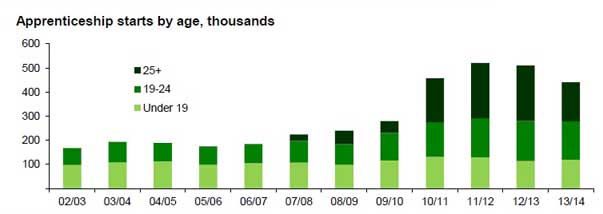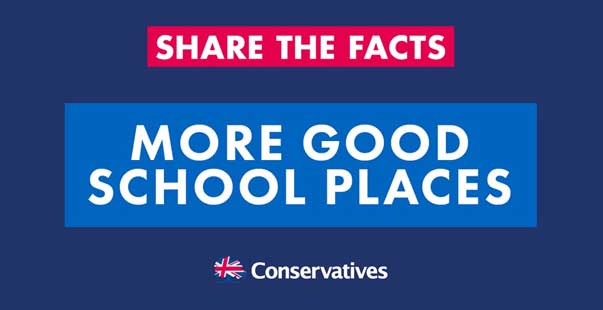The Conservatives’ online election machine is busy pumping out claims and statistics under the banner “share the facts”. If you click on the “share” button you get points, which you can cash in for unspecified “rewards” (mugs, mostly, we think).
FactCheck was about to click – but we thought we’d check some of the claims the Conservatives are making about education and training first.
 ‘There are now one million more children in good and outstanding schools.’
‘There are now one million more children in good and outstanding schools.’
This reflects the fact that more English schools are being rated “good” or “outstanding” by the education inspectorate Ofsted.
If you count up all the pupils in those schools, it comes to more than a million.
We don’t have a problem with that, but Ofsted figures are not as straightforward as they look. There’s a “skew in the sample”.
On the face it, 81 per cent of all schools in England were rated “good” or “outstanding” in 2014, compared to 68 per cent in 2010, which sounds like a stunning success.
But Ofsted made a big change to the way it operates in 2009. It decided to concentrate on inspecting schools previously found to be “satisfactory” or “inadequate” and make fewer repeat visits to better schools.
A school judged “outstanding” at its last inspection won’t be inspected again unless a risk assessment indicates a serious risk of decline.
Of the 6,469 schools actually inspected by Ofsted in 2014, only 63 per cent were rated good or outstanding. These were added to the stock of schools which had already found to be in the top categories and were not checked again, to get a cumulative total of 81 per cent.
So the way the system is set up makes it easier for the ‘good and outstanding’ slice of the pie to grow every year.
Is it fair to assume that a school, once judged to be “outstanding”, is likely to carry on being excellent without needing another inspection? Maybe, but we know that this doesn’t hold true in all cases.
After the “Trojan Horse” scandal in which when some Birmingham schools were alleged to have come under the influence of a hardline Muslim group, schools previously rated “outstanding” were reassessed and demoted to the lowest possible status – “inadequate”.
 ‘We’ve created 2 million apprenticeships, giving young people the start in life they need to secure a better future.’
‘We’ve created 2 million apprenticeships, giving young people the start in life they need to secure a better future.’
Again – no dispute about the numbers here. Arguably though, it’s a bit of a stretch to link the growth of apprenticeships to “giving young people the start in life they need” – because most of the new apprenticeships have not gone to the youngest.
The biggest growth market is the over-25s, as this House of Commons Library graph shows:
Apprenticeships for under-19s (the pale green bit) have been almost exactly flat for years.
In 2013/14 120,000 under-19s began an apprenticeship, up a tiny bit (3 per cent) from the 2009/10 figure but down from 2010/11.
Again, this sounds good, but it takes a bit of unravelling.
The Tories’ blurb explains: “We’re creating more good school places… since 2010 there are over a million more children being taught in schools rated good or outstanding – and we’re committed to going further.
“With the next wave of our free school programme, there are 230,000 more good school places already created or in the pipeline – and we’re on course to create 270,000 more in the next parliament. That’s half a million more good school places overall.”
It’s true that the Conservative-led coalition has been building free schools – which are set up by parents’ groups, charities and other organisations and funded directly by central government.
But the claim that they will deliver half a million extra school places is questionable.
This only works if you lump together all the schools actually open (251 as of last year) and those that are “in the pipeline” to get a total of more than 400 open or approved.
Theoretically, these schools could eventually house 230,000 pupils, which works out at 575 children per school. But the average free school operating now only has about 150 pupils.
There’s nothing sinister about this, it’s just that free schools naturally tend to start off small as they don’t draw from local feeder schools, and some only accept pupils into the youngest year groups.
The number of pupils probably will grow over time – but free schools won’t deliver all those extra places claimed by the Conservatives for some years.
And that will be true of the 270,000 equally theoretical places the Conservatives say they will supply by setting up 500 more free schools over the next parliament.
Of course this aspiration for the next parliament all depends on people who actually want to set up the schools in the first place coming forward.
As far as we can see, the phrase “good school places”, which is becoming a bit of a Conservative mantra, is pretty meaningless.
It sounds like what is being promised here are places in schools which Ofsted have judged to be “good” (or “outstanding”).
But if the schools haven’t even been built yet, they can’t have been inspected by Ofsted yet, so we have no idea whether the promised places will be in “good” schools or not.
A party spokesman told us the claims for the numbers of places “are based on current predictions and the pipeline of free schools – they aren’t commitments or targets”.
He defended the talk of “good school places” by saying that “free schools perform better than council run schools”.
But that is highly debatable.
It’s perfectly true that 24 per cent of free schools were judged to be outstanding at the end of 2013/14 compared to 10 per cent of state schools.
Equally, we could say that four free schools were rated as inadequate (5 per cent) compared to 3 per cent of all other schools.
In both cases it’s not really a fair comparison, because a) all the free schools were inspected under a new Ofsted framework introduced in September 2012, and not all the other schools were and b) the free schools sample size was tiny: only 76 schools in total had been inspected by the end of 2013/14.
The House of Commons library says: “The number of free schools inspected so far is still quite small and so provide little firm evidence on performance so far.”
And the UK Statistics Authority says: “The question of how to compare free school inspection outcomes with other schools in a fair way appears to remain unresolved by the experts.”
So that’s it. Now share the real facts (no mugs available).







